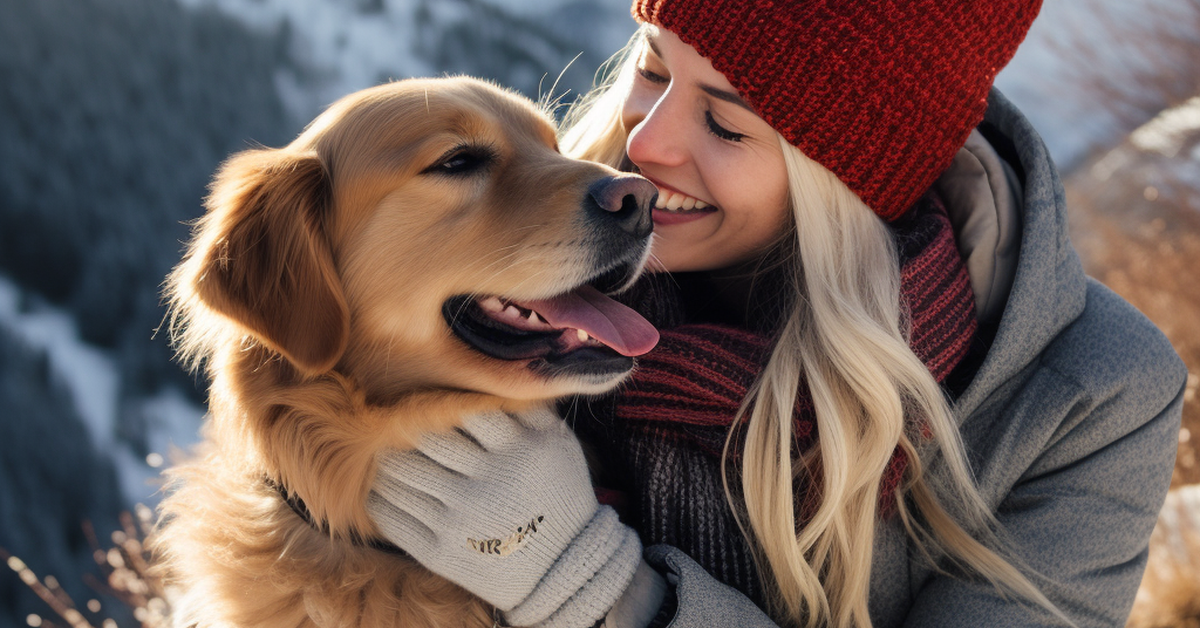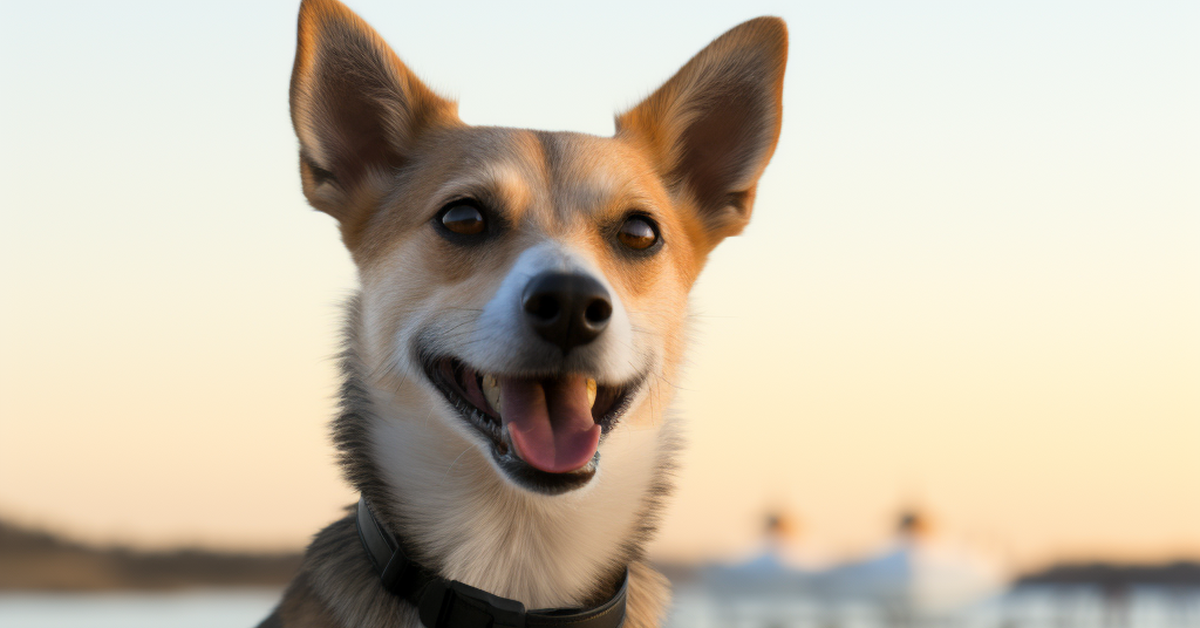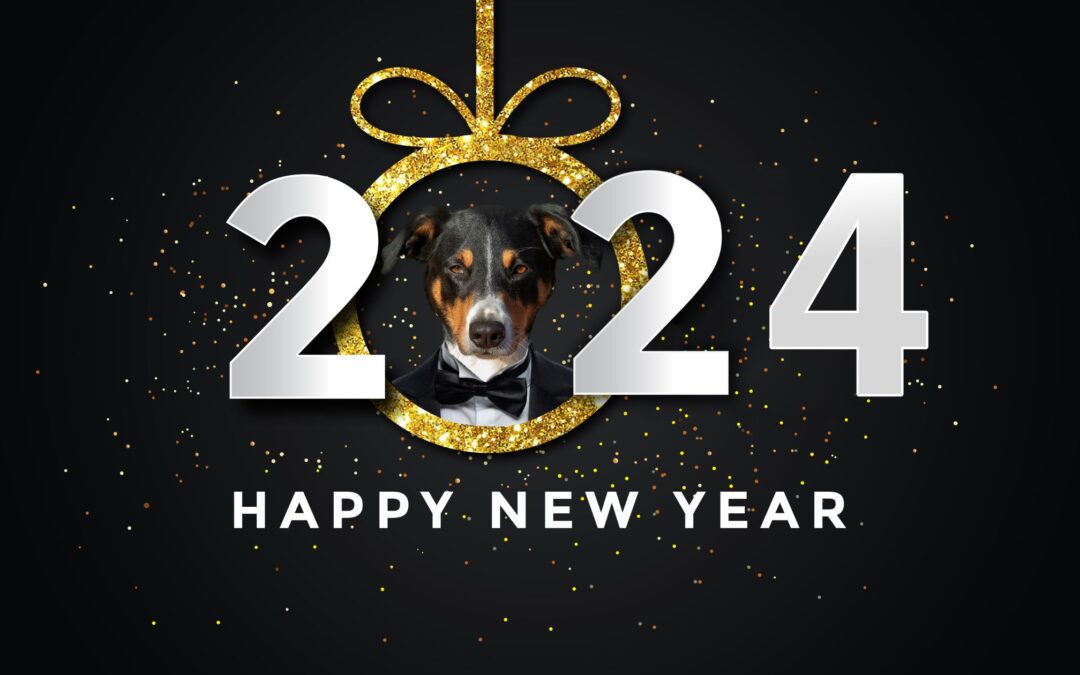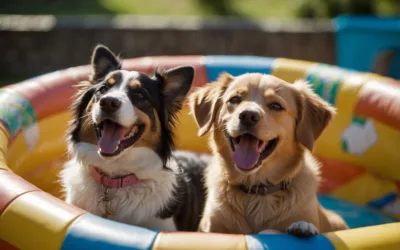7 New Year’s Resolutions For Your Dog: Boost Health & Joy!
Ever thought about New Year’s resolutions for your furry best friend? Well, it’s about time we consider our dog’s health and joy, just as we do ours at the start of a fresh year. New Year’s resolutions for your dog can be a fun and meaningful way to enhance their wellbeing. We’re not just talking walks and treats; we mean real, beneficial changes that will make their tails wag harder than ever before. So, let’s dive into seven paw-some resolutions that will help your dog have a yappy and healthy year ahead.
When we chat about resolutions, it’s not all about us humans. Our four-legged pals deserve to have goals that push them toward a happier life. Think about it: they give us unconditional love, so why not pay that forward by ensuring their year is filled with health and happiness? From improving their diet to learning new tricks, each resolution is a step toward a stronger bond and a better life for your beloved pooch. You might think it’s a quirky idea, but setting these goals can really make a difference in your dog’s quality of life.
Now, let’s get ready to Improve Your Dog’s Diet – the first resolution on our list. It’s not just about cutting down on treats or switching to a high-quality kibble. It’s about understanding what nourishes them and tailoring their diet to their age, breed, and health needs. Stick with us as we unveil how these tweaks in your dog’s diet can lead to leaps in their health and overall happiness. Say goodbye to the old doggy dinner routine and hello to a meal plan that will have your pup prancing with joy!
Improve Your Dog’s Diet

A dog’s diet is a key pillar of their well-being. Just like us, they need a balance of proteins, fats, carbs, and essential vitamins. Feeding your dog the right food in the correct portions is a game-changer. It can impact everything from their energy levels to the shine of their coat. Let’s dig into how you can upgrade your pup’s meals this year.
Feeding Your Furry Friend Right
Your dog’s health hinges on the food they eat. Kibble might be convenient, but is it the best choice? More and more pet parents are mixing in fresh, whole foods. Think lean meats, veggies, and grains. These can help your dog feel and act younger.
Choosing Quality Chow
What’s in your dog’s bowl matters. Look for food with real meat as the first ingredient. And size does matter – portion sizes, that is. Overfeeding is a no-go. It can lead to obesity and health issues. A quick chat with your vet can help nail down the perfect portion for your pooch.
Fresh Food Benefits
Table scraps are tempting, but they’re not always safe. Instead, consider safe, fresh foods. Carrots can be a crunchy treat. Plain, cooked chicken can be a protein-packed snack. Both can be part of a balanced diet.
Nutrients They Need
Dogs need a variety of nutrients. Protein builds muscles. Fats give energy. Carbs fuel the fun. And vitamins? They keep everything running smoothly. Always check with your vet before making big diet changes.
Portion Control
Too much of a good thing can be bad. Same goes for dog food. Use a measuring cup for kibble. And remember, treats should be just that – occasional treats.
The Upside of Upping Their Diet Game
- Shinier coat
- Better digestion
- More zest for life
- Stronger immunity
Making Mealtime Meaningful
It’s not just what you feed your dog. It’s how you feed them. Regular feeding times help with digestion. No free feeding. It can lead to overeating.
Remember, quality food isn’t just a resolution. It’s a commitment to your dog’s health.
Ready for a Recipe Reboot?
Here’s a simple breakdown of what a balanced dog diet looks like:
| Food Type | Benefit | Example |
|---|---|---|
| Protein | Muscle maintenance | Chicken, fish |
| Fats | Energy and shiny coat | Salmon oil |
| Carbohydrates | Digestion and energy | Brown rice |
| Vegetables | Vitamins and fiber | Carrots and peas |
| Fruits | Antioxidants and natural sugars | Apples (no seeds!) |
| Water | Hydration | Fresh, clean water |
And as we ponder on how to maintain our dog’s health and happiness, it’s also worth considering how we can enhance their daily experiences. Imagine walks that not only exercise their body but also stimulate their mind. A world where every sniff, every new trail, is an adventure, a chance to leap into a healthier, more engaged existence. Keep your eyes peeled for fresh ideas to invigorate your dog’s routine and enrich those precious moments you share.
For more tips on improving your dog’s diet, check out our article on the benefits of fresh food and start transforming mealtime into a health-boosting ritual.
Increase Physical Activity

Throw away the old couch potato habits. Your dog needs more than a quick sprint around the block. Different dogs crave different kinds of workouts. Think about it. Does a tiny terrier have the same exercise needs as a burly boxer? Not really.
Here’s a simple plan to amp up the pep in your pup’s step:
- Match the activity to your dog’s breed. A Chihuahua might not need as much run time as a Retriever.
- Regular walks are key. Aim for twice a day. It helps keep the waistline in check and the tail wagging.
- Playtime isn’t just for kids. Fetch, tug-of-war, or frisbee can be great ways to get the heart pumping.
Exercise by the Numbers
- 30 minutes to 2 hours: That’s how much exercise dogs need daily, depending on their breed and size.
- Over 50% of dogs in the US are overweight. Extra playtime can slash that stat.
- 1 out of 3: The number of dog owners who admit they don’t walk their dogs regularly.
Tailored Activities For Every Tail
| Breed Type | Suggested Activity | Frequency |
|---|---|---|
| Small | Short walks, indoor play | Daily |
| Medium | Park visits, jogging | 3-5 times a week |
| Large | Hiking, swimming | 2-4 times a week |
Remember! Your dog’s health and happiness hinge on staying active. Just like us, they need to move to stay spry.
Routine Equals Results
- Set a schedule. Dogs love routine, and so should you.
- Make it mutual. You get fit with your dog; it’s a win-win.
- Check with the vet. Before starting any new exercise plan, get a thumbs-up from your pooch’s doc.
Let’s wrap this up and stride towards an even healthier lifestyle. Just picture those extra tail wags as you both enjoy the fresh air and sunshine. Who knows, with all this bounding and leaping, you might stumble upon a hidden talent your dog’s been holding out on. Take a look at our blog post on the benefits of walking your dog.
Enhance Mental Stimulation

Your dog’s brain craves challenge just like ours. It’s vital for their happiness and overall well-being. So, let’s talk about sparking that mental fire in your furry friend. Here are some smart ways to ramp up your dog’s brainpower.
Interactive Toys and Puzzles
These toys are like a gym for your dog’s brain. They can keep Fido engaged for hours, and best of all, they come in various difficulty levels. From simple treat-dispensing balls to intricate puzzle boards, there’s something for every dog.
Training and New Tricks
It’s true when they say you can’t teach an old dog new tricks. But you should! Training is not just for puppies. Older dogs benefit, too. It keeps their minds nimble. Learning commands like ‘sit’ or ‘stay’ or fancier tricks can be a blast.
Playtime Is Brain Time
Games like hide and seek or fetch are not just physical. They make your dog think and anticipate. It’s a great way to combine exercise with mental stimulation. Plus, it’s a fun way for you both to bond.
Here’s a cool stat: according to a study, dogs that play more have been shown to have better cognitive function as they age. That’s a win-win – more play equals a smarter, happier dog.
Now, let’s look at a list of stimulating activities you might try:
- Teaching your dog to name their toys.
- Playing the shell game with treats.
- Setting up an obstacle course in the backyard.
Remember, the goal is to keep your dog’s brain active and engaged.
| Activity Type | Potential Benefits |
|---|---|
| Interactive Toys | Enhances problem-solving skills |
| Training Sessions | Improves concentration and memory |
| Playtime | Boosts overall cognitive function |
As we wrap up, think about how you can incorporate these ideas into everyday life with your dog. Perhaps you’ll start with a new game tomorrow or introduce a training session once a week. Small changes can lead to big improvements in your dog’s mental health. And as they enjoy these new challenges, they’ll be gearing up for a year of fun and learning. Just like we need to keep our minds active to stay sharp, the same goes for our canine companions. It’s not just about a wagging tail but also about a bright, engaged mind as they step into each new day with excitement.
Now, imagine your dog eagerly waiting for the next game or puzzle, ready to tackle it with gusto. That’s the kind of joy and health we want for our dogs as we move forward. And who knows? This new focus on mental stimulation might just pave the way for more amazing adventures together. Keep an eye out for ways to keep those tails wagging and minds active.
Focus on Dental Health
Dogs need their teeth taken care of just like us. It’s crucial for their health and happiness. You might not know this, but caring for your dog’s teeth can prevent other health issues later on. That’s right, keeping those chompers clean is more than just for a pretty smile!
Why is Dental Health Important?
It’s simple. Good dental health can prevent bad breath, tooth loss, and painful infections. Plus, it can even stop other serious diseases. Did you know that 80% of dogs show signs of dental disease by age three? That’s a stat worth chewing over.
Your Dog’s Dental Routine
Here’s a guide to keep your furry friend’s teeth sparkling:
- Choose the right toothbrush and toothpaste for dogs, not human products.
- Brush those teeth regularly, ideally several times a week.
- Give them dental chews or toys that help clean teeth.
How to Brush Your Dog’s Teeth
First, pick a calm time. Let your dog taste the toothpaste. Then, gently brush with circular motions, focusing on the outside of the teeth.
Dental Health Products for Dogs:
- Special toothpaste
- Finger brushes
- Dental chews
- Water additives
Table of Recommended Dental Health Products
| Product Type | Description | Frequency of Use |
|---|---|---|
| Toothpaste | Enzymatic toothpaste for plaque control | Daily |
| Toothbrush | Soft bristles and easy grip | Daily |
| Dental Chews | Helps reduce tartar build-up | As directed |
| Water Additives | Freshens breath and cleans teeth | With each refill |
Remember, these steps can keep your dog healthy and save you vet trips. It’s a win-win!
Now, as we think about our dog’s well-being, we should also consider how their routine checkups can play a part in their overall health. Just imagine how a regular visit to a professional can ensure our furry pals stay in top shape, ready to tackle the year with us.
Schedule Regular Vet Visits
A stitch in time saves nine, they say. This rings true for your dog’s health too. Regular vet visits are like a health shield for your furry pal. These check-ups keep illnesses at bay and ensure your dog stays as bouncy and joyful as ever.
When you take your dog to the vet, expect a thorough examination. The vet will check your dog’s weight, skin, coat, eyes, ears, and mouth. They might also need a blood test or other procedures. To prepare, bring along your dog’s health records and jot down any concerns.
Here’s a quick glance at what to keep track of for your dog:
| Health Aspect | What to Monitor |
|---|---|
| Weight | Check monthly |
| Vaccinations | Follow vet’s schedule |
| Dental Health | Annual check-ups |
| Preventative Medications | As prescribed |
Regular check-ups can catch issues early. This means better outcomes for your dog and often lower vet bills for you. Plus, a healthy dog means more adventures together, more cuddles, and more memories.
Remember, your dog’s health records are important. Keep them updated. The records help new vets understand your dog’s history. They’re also handy when you travel with your pooch.
Now, let’s take a peek at the future. Think about more than just health. Picture your dog learning new ways to socialize. Imagine them playing happily with other dogs in the park or greeting neighbors with a gentle nuzzle. These joyful encounters are just as vital for their well-being as a clean bill of health.
Here’s some inspiration for you and your furry friend as you venture into a new year filled with possibilities. Don’t forget to check out our travel blog for tips on making trips with your dog as smooth as their coat after a good brush.
Foster Socialization Skills
Your dog’s happiness hinges on their ability to make pals, just like us humans do. Let’s talk about how crucial it is for dogs to mingle and get along with others. This’ll boost their confidence and keep them from getting all worked up around new critters or folks.
Benefits of Doggo Social Skills
Did you know? Pups that play well with others often turn out to be more well-behaved. They’re less likely to get spooked or lash out when they meet new friends or humans.
Safe Socializing Strategies
Now, introducing your furry pal to new buddies should be done bit by bit. Here are some pointers:
- Start young: Puppies soak up new experiences like a sponge. The sooner you start, the better.
- Keep it chill: Don’t throw your dog into a social whirlwind. A calm intro can make a world of difference.
- Be positive: Treats and praise go a long way when they make new friends or act polite around people.
Handling Social Hiccups
Even the friendliest pups might hit a snag now and then. Maybe they get a bit too excited or shy away. Staying patient and keeping encounters positive can help smooth out these bumps.
Table: Socialization Benefits & Techniques
| Benefit | Technique |
|---|---|
| Better Behavior | Gradual Introductions |
| Reduced Fear | Controlled Environments |
| Increased Happiness | Positive Reinforcement |
So, you’re all set to guide your furry bestie into becoming a social butterfly. Next up, we’ll ease into another key aspect of your dog’s well-being. Imagine a spa day, but for your pup – it’s all about keeping them spick and span and as happy as can be!
Develop a Grooming Routine

Caring for your dog means more than feeding and playtime. Grooming is vital for their health. You might wonder, “How often should I groom my dog?” Well, it depends on the breed and their lifestyle. Regular grooming keeps your pup comfortable and snuggly.
Essential grooming tasks include brushing, bathing, nail trimming, and ear cleaning. Don’t forget dental care, too. For brushing, short-haired breeds might be fine with weekly brushing, but long-haired dogs often need daily attention to avoid painful mats. Bathing can range from monthly to a few times a year, depending on your dog’s activities and skin health. Nail trims should happen monthly, and ear checks are a weekly event.
Here are tips to make grooming a treat, not a chore:
- Start young: Introduce your pup to grooming early so it becomes a normal part of their routine.
- Praise and treats: Reward your dog for good behavior during grooming sessions.
- Be gentle: Use the right tools and take your time to avoid discomfort.
- Know when to seek help: Some tasks, like nail trimming, can be tricky. If you’re unsure, a professional groomer can step in.
Check out these grooming stats:
- 75% of dog owners groom their dog at home.
- Only 20% of owners brush their dog’s teeth regularly.
- About 5% of vet visits are due to grooming-related issues.
Now, let’s outline a basic grooming schedule in table format:
| Task | Frequency | Notes |
|---|---|---|
| Brushing | 1-7x per week | Varies by coat type; prevents matting |
| Bathing | 1-12x per year | Based on activity level and skin conditions |
| Nail Trimming | Monthly | Prevents overgrowth and walking discomfort |
| Ear Cleaning | Weekly | Essential for breeds with floppy ears to prevent infection |
| Teeth Brushing | 2-3x per week | Prevents dental issues and keeps breath fresh |
Incorporating a routine like this can make grooming less daunting. Remember, grooming isn’t just about looks. It’s a health necessity that can prevent many issues down the line. Plus, it’s bonding time with your furry pal.
- Brushing: It’s not just fur deep; it distributes natural oils and catches loose hair before it ends up on your couch.
- Bathing: Keeps the skin healthy and your dog smelling fresh.
- Nail Trimming: Overgrown nails can cause pain and even lead to posture problems.
- Ear Cleaning: This can prevent ear infections, a common issue in many breeds.
- Teeth Brushing: Dental health in dogs is often overlooked but crucial for overall health.
So, as you and your pup embark on this year of growth and health, consider these grooming resolutions. They might seem small, but they make a big difference in your dog’s quality of life. And who doesn’t want to see their dog happy, healthy, and ready for cuddles?
Next up, we’ll talk about wrapping up our chat on doggy care. We’ve covered lots to keep your best friend in top shape. Remember, every small step you take makes your pup’s life better. And isn’t that what the yappy life is all about?
Conclusion
Hey there, dog lovers! We’ve chewed over some top-notch resolutions to make your furry friend’s tail wag like never before. Trust me, embracing these 7 New Year’s Resolutions will spruce up your pup’s life and add a wag to their walk. It’s all about going the extra mile for our four-legged pals because they deserve it. So, let’s stand together, paws united, and make a pinky promise to our pooches to stick by these commitments. They rely on us to make the best choices for their happy, yappy lives.
Frequently Asked Questions about NEW YEAR’S RESOLUTIONS FOR YOUR DOG
What are some common New Year’s resolutions for dog owners?
Dog owners often resolve to improve their dog’s health and happiness in the new year. This can include commitments to regular exercise, healthier feeding practices, more consistent training, regular veterinary check-ups, dental care, spending more quality time together, and ensuring mental stimulation through games and new experiences.
How can I help my dog get more exercise?
To help your dog get more exercise, you can increase the length or frequency of walks, incorporate playtime into your daily routine, try out new activities like hiking or swimming, or enroll your dog in a doggy daycare or agility class for added physical stimulation.
Why is a healthier diet important for my dog?
A healthier diet is crucial for maintaining your dog’s optimum weight, ensuring they receive the necessary nutrients for energy and health, and can prevent diet-related diseases. It can also contribute to healthier skin, a shinier coat, and better overall vitality.
What kind of training should I focus on for my dog this year?
Focus on basic obedience training, such as commands like sit, stay, come, and heel. Additionally, work on any behavioral issues your dog may have, like excessive barking or chewing. Consistent training improves communication and strengthens the bond between you and your dog.
How often should my dog visit the vet?
It’s recommended for dogs to have at least an annual wellness checkup. However, puppies, senior dogs, or those with health issues may need to visit the vet more frequently. Regular check-ups can catch health problems early when they are most treatable.
What type of dental care is appropriate for dogs?
Dental care for dogs should include regular brushing with dog-specific toothpaste, dental treats or chews that help reduce plaque and tartar, and professional dental cleanings as recommended by your vet.
How can I make sure I’m spending quality time with my dog?
Quality time with your dog can be as simple as focused play sessions, cuddling, grooming, or training together. It’s important to be present and engaged during these times, without distractions like phones or other devices.
What are some mental stimulation activities I can introduce to my dog?
You can introduce puzzle toys, scent games, new tricks, or obedience skills to mentally stimulate your dog. Interactive play with other dogs or supervised play with children can also be beneficial for your dog’s mental engagement.
Can I teach my old dog new tricks as a New Year’s resolution?
Yes, you can teach an old dog new tricks! Dogs of all ages can learn and enjoy the mental stimulation that comes with training. Adjust the training to fit their physical abilities and patience level.
How should I track my dog’s progress with New Year’s resolutions?
Track your dog’s progress by setting specific, measurable goals and keeping a journal or log of activities and achievements. Regularly review and adjust your goals as needed to ensure they remain realistic and attainable for both you and your dog.





Recent Comments